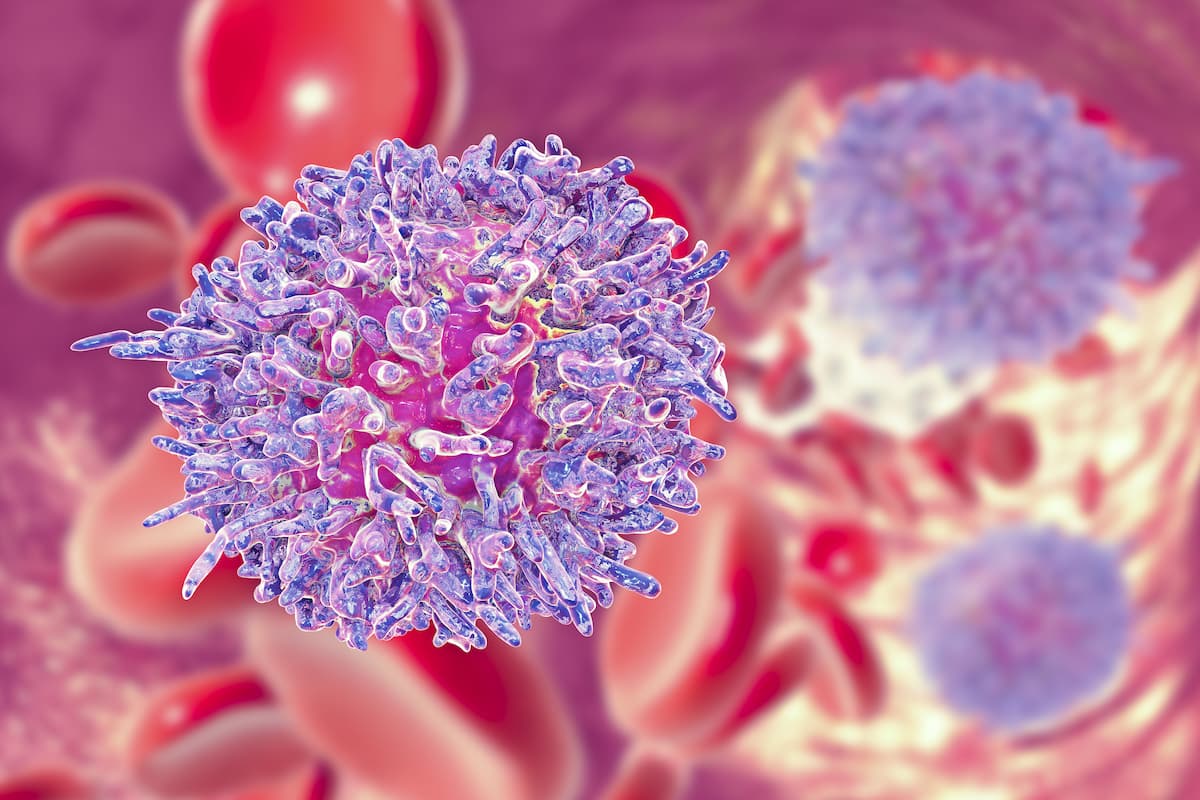BR-VR Yields Acceptable Safety in Untreated Chronic Lymphocytic Leukemia
Investigators report that bendamustine/rituximab debulking appears to decrease tumor lysis syndrome risk in patients with previously untreated chronic lymphocytic leukemia.
This phase 2 study (NCT03609593) included patients with previously untreated CLL and small lymphocytic leukemia who were 18 years of age or older and needed treatment by International Workshop CLL criteria.

Bendamustine/rituximab (Rituxan) induction plus venetoclax (Venclexta)/rituximab consolidation (BR-VR) resulted in positive safety findings in a population of patients with previously untreated chronic lymphocytic leukemia (CLL), according to findings from a multicenter, open-label phase 2 study (NCT03609593).
After 3 cycles of treatment with BR induction (n = 38), the overall response rate (ORR) was 100%, including partial responses (PRs) in 84% of patients and complete responses (CRs) in 16%. Additionally, 26% of patients had undetectable minimal residual disease (MRD) in the peripheral blood (n = 31), including a level of less than 0.01% in 26%, 0.01% to 1.0% in 42%, and over 1% in 32%. Moreover, 33% of patients had undetectable MRD in the bone marrow (n = 33), with levels of less than 0.01%, 0.01% to 1.0%, and over 1% in 33%, 30%, and 36%, respectively.
The ORR of 100% was maintained in cycle 15 during the VR treatment, with a PR rate of 21% and CR rate of 79%. Additionally, MRD was undetectable in the peripheral blood and bone marrow in 80% and 78% of patients, respectively. Of note, 20% and 18% of patients had intermediate MRD, respectively.
The study included patients with previously untreated CLL and small lymphocytic leukemia who were 18 years of age or older and needed treatment by International Workshop CLL criteria. To be included in the study, patients needed to have an ECOG performance status of 0 to 2, a hemoglobin of 8 g/dL or more, an absolute neutrophil count of 1000/mm3 or more, and a platelet count of 50,000/mm3.
Patients who enrolled on the study received 3 cycles of treatment with bendamustine at 50 to 90 mg/m2 every day for 2 days plus 375 mg/m2 of rituximab every 28 days; this was followed by venetoclax at a standard dose escalation of 20 mg to 400 mg every day over the course of 5 weeks, coupled with 6 cycles of treatment with VR, including monthly rituximab and 5 cycles of venetoclax.
The study had a primary end point of ORR, with secondary end points including undetectable MRD, time to undetectable MRD, and adverse effects.
A total of 42 patients were included in the study as of the data cutoff of July 15, 2023. Most patients were male (n = 29), and the median patient age was 61.5 years. Fifty-two percent of patients did not have IGHV-mutant disease. TP53-aberrant disease was observed in 5% of patients, del(11q) in 7%, and complex karyotypes in 26%. Moreover, in a population of 24 evaluable patients, the risk of tumor lysis syndrome was high in 21%, medium in 52%, and low in 26%.
A total of 37 patients continued on the study at a median follow-up of 16.6 months (range, 3-40). A single patient was reported to have radiographic disease after finishing 15 months of therapy, although they are still being observed, as they don’t meet the criteria for subsequent therapy. Moreover, 3 patients died during the study due to COVID-19 infection (n = 2) and new metastatic squamous cell carcinoma development (n = 1).
Bendamustine was given at a dose of 50 mg/m2 in 11% of patients, 70 mg/m2 in 13%, and 90 mg/m2 in 76%.
Frequent any-grade and high-grade treatment-emergent adverse effects (TEAEs) in patients who underwent induction therapy included anemia (36% and 10%), nausea (21% and 0%), neutropenia (29% and 19%), rash (29% and 2%), constipation (17% and 0%), and infusion reactions (17% and 2%); additionally, 5% of patients had febrile neutropenia during this stage. Additionally, any-grade and high-grade TEAEs that occurred during treatment with venetoclax included neutropenia (50% and 31%), diarrhea (43% and 0%), leukopenia (24% and 10%), and nausea (26% and 0%).
Additionally, initial treatment with BR resulted in a notably lower risk of tumor lysis syndrome. Of those who were at high risk for developing tumor lysis syndrome at baseline, 1 was still high risk after BR along with 5 of 16 patients who were medium-risk.
Reference
Lipsky AH, Hill BT, Winter A, et al. High rates of undetectable minimal residual disease remissions with time-limited bendamustine, rituximab, and venetoclax (BR-VR) in untreated chronic lymphocytic leukemia (CLL). 2023 Society of Hematologic Oncology (SOHO) Annual Meeting; September 6-9, 2023; Houston, TX. Poster CLL-542.
Newsletter
Stay up to date on recent advances in the multidisciplinary approach to cancer.